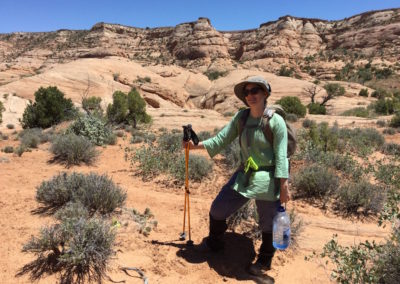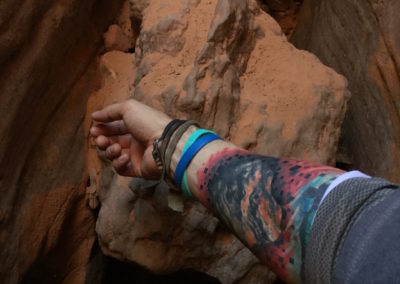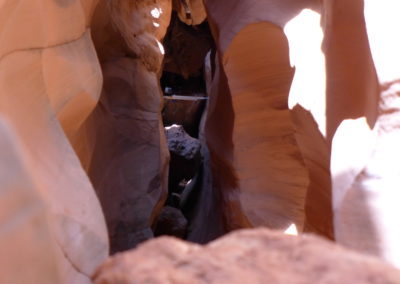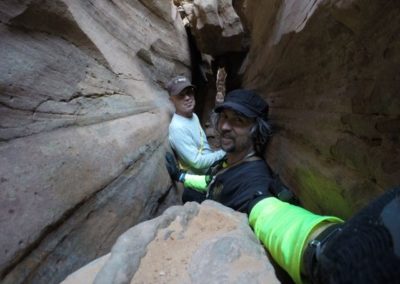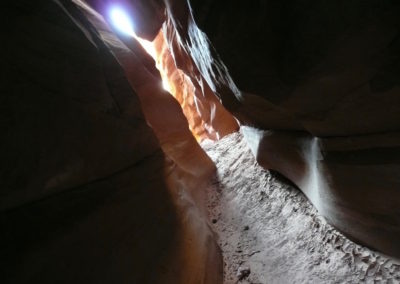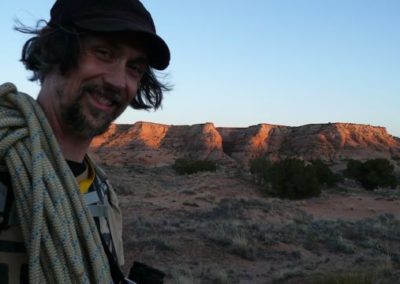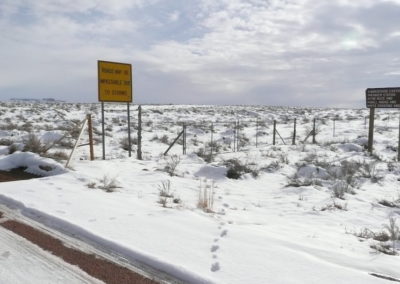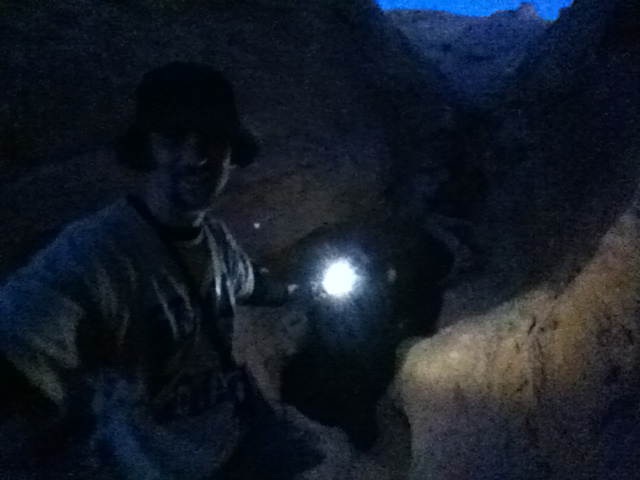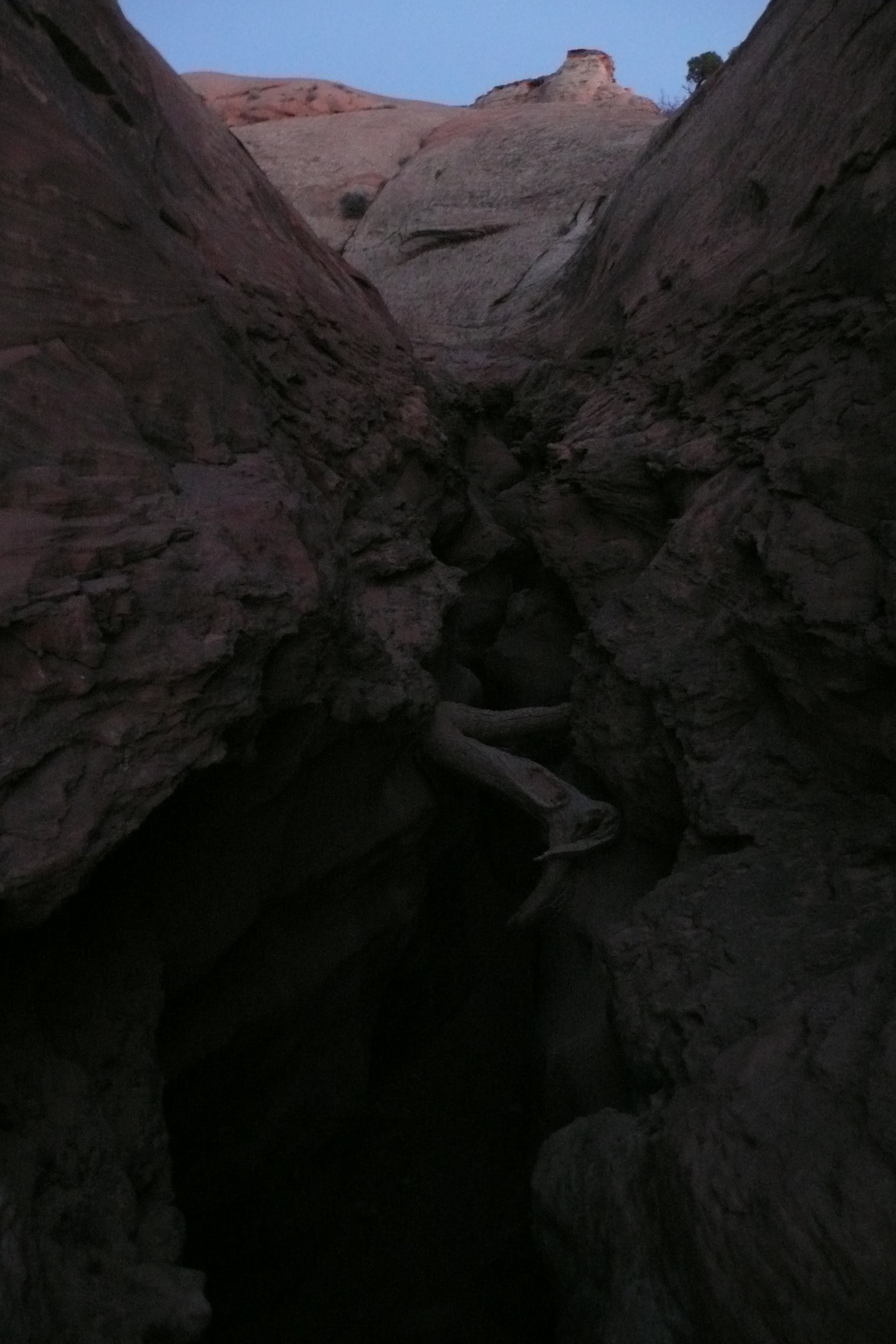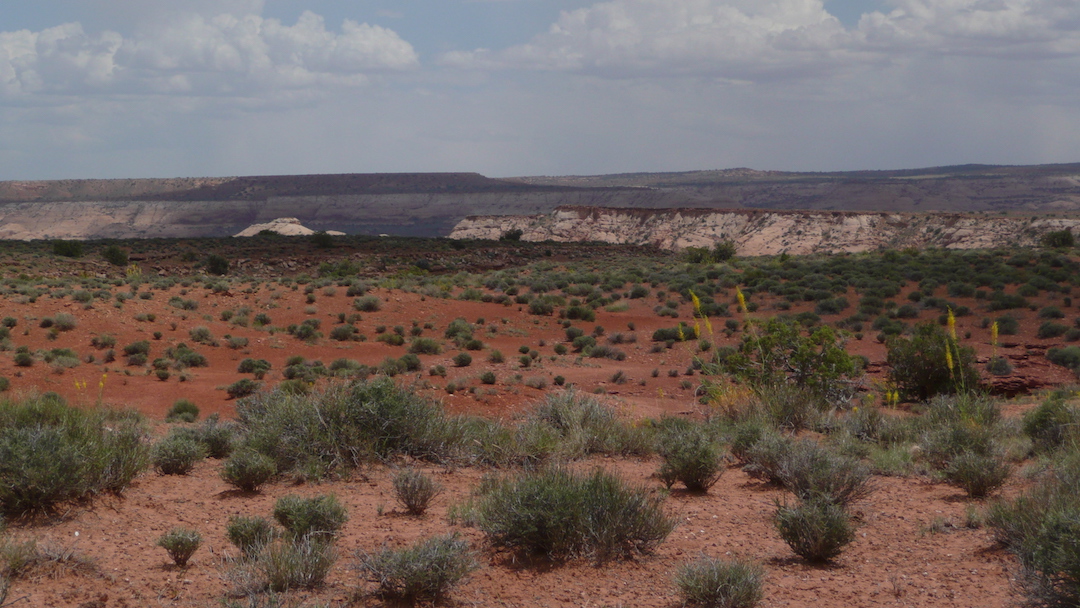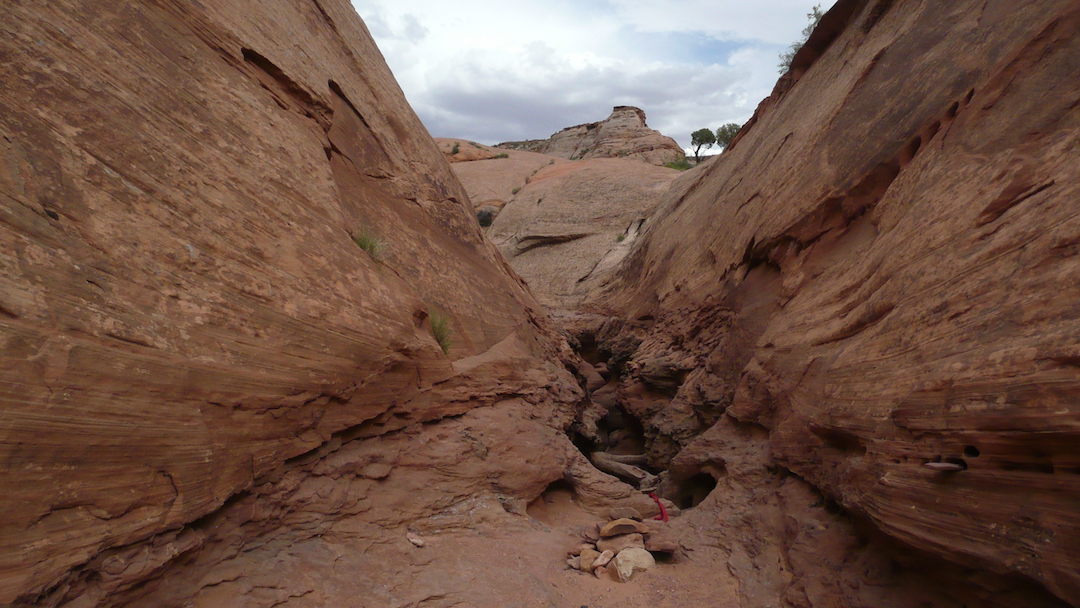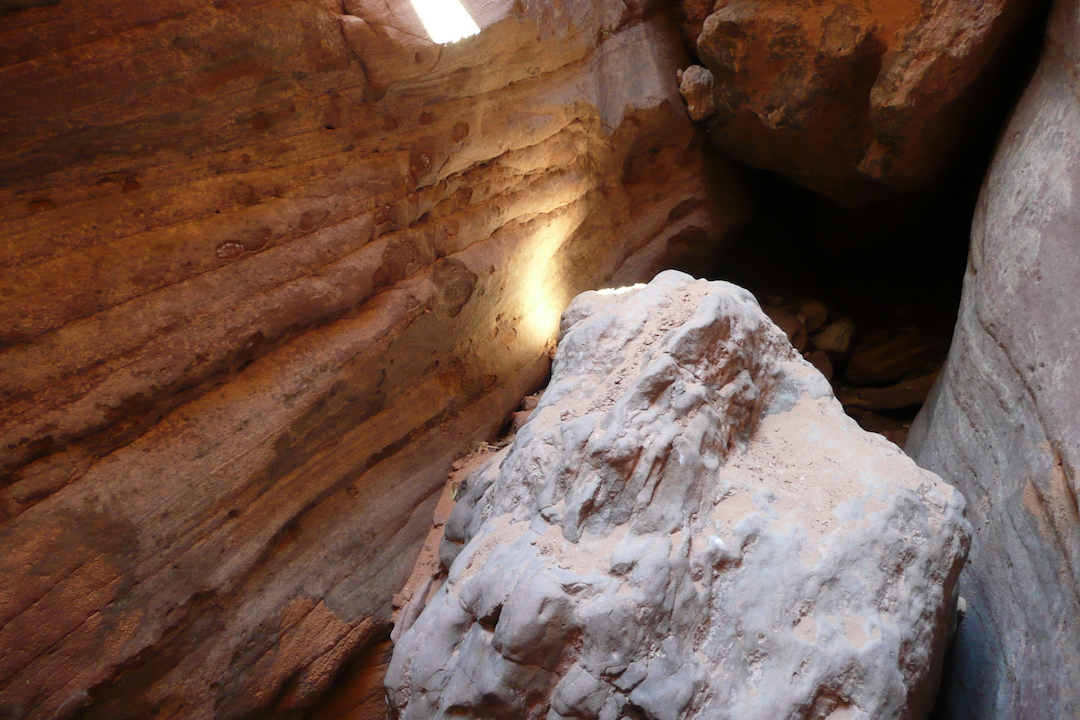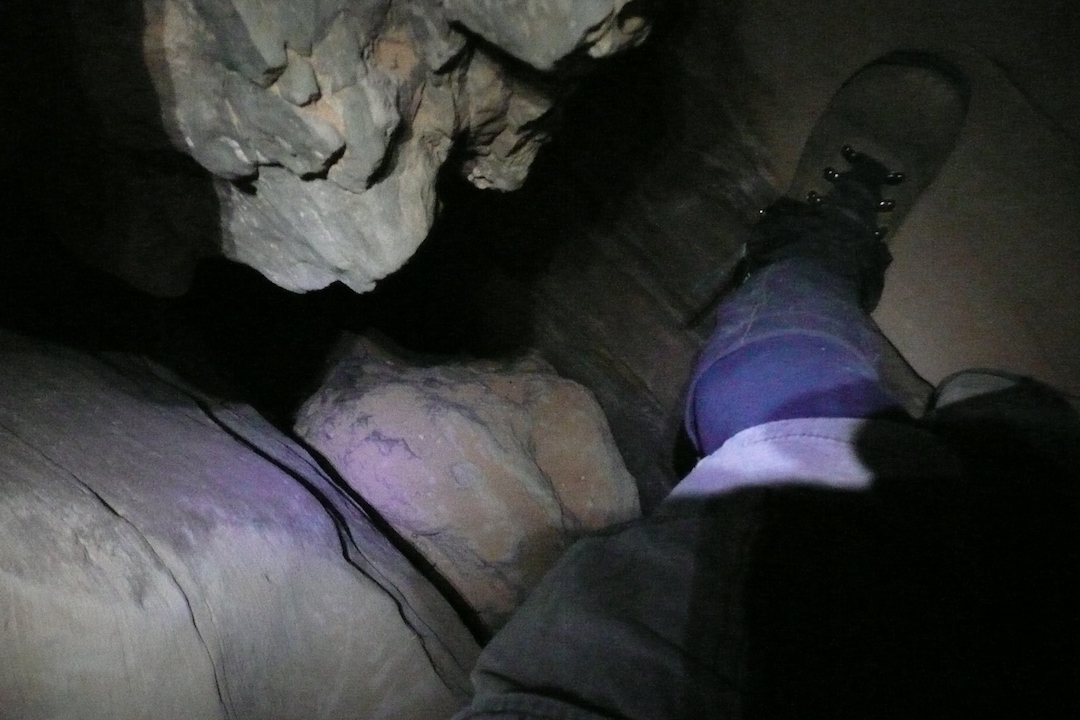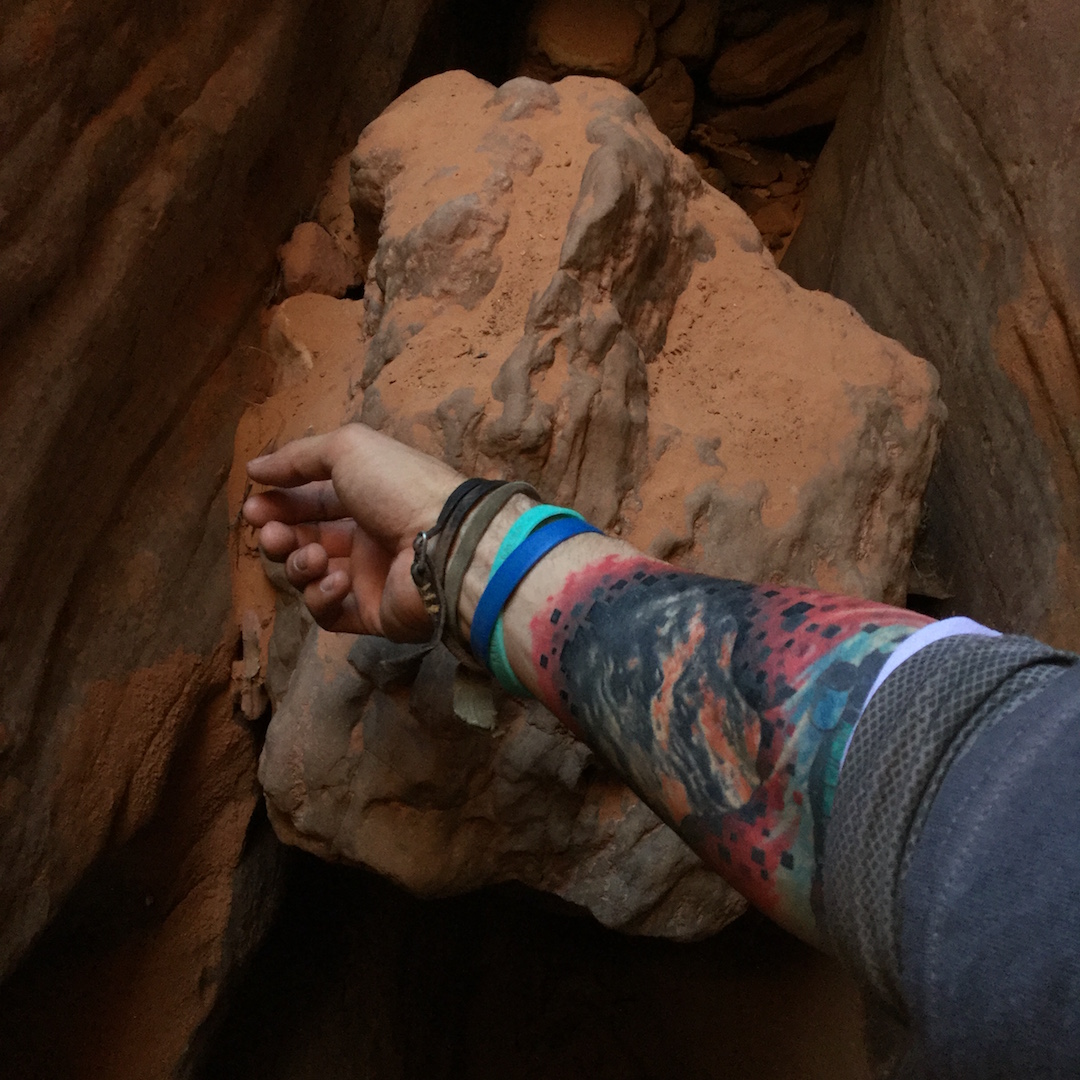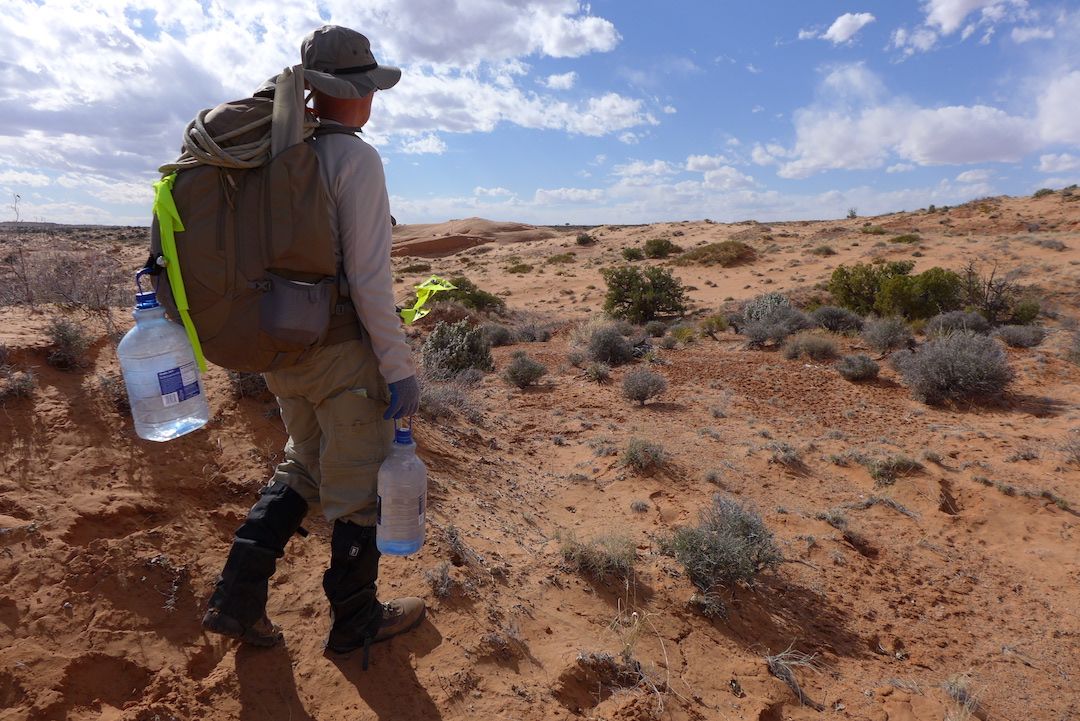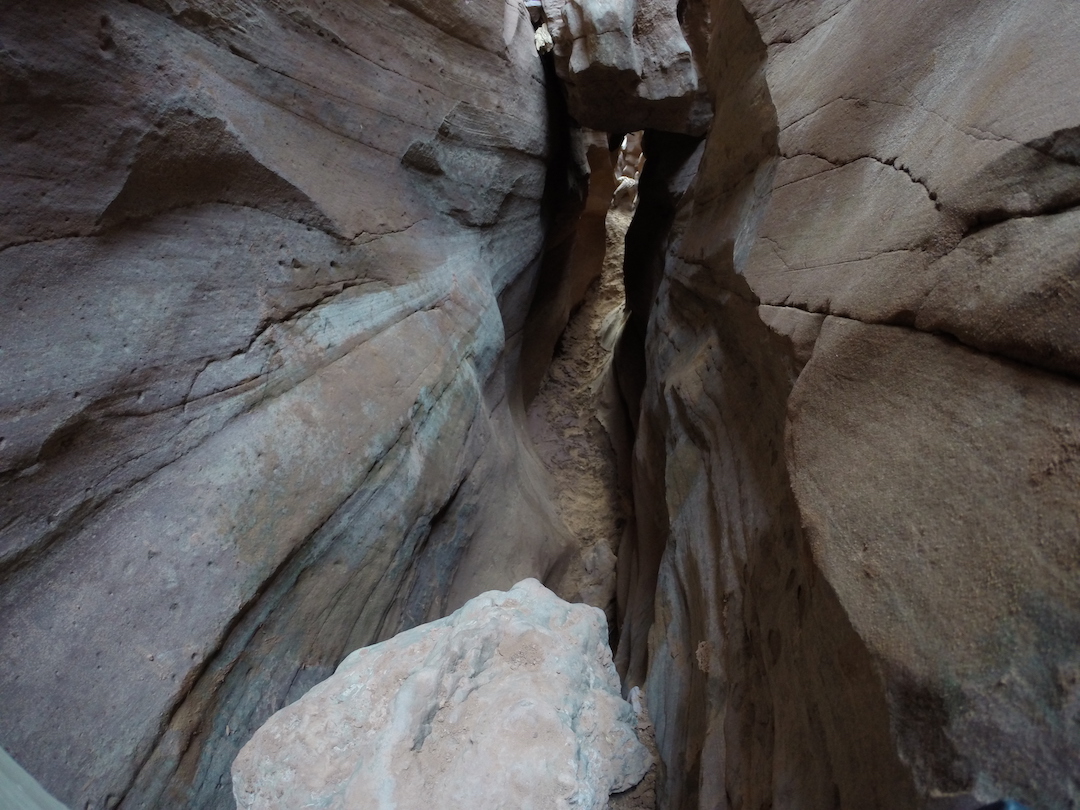Finding Bluejohn canyon & the Ralston boulder
by Matthew D. Wittmer
Last updated February 2021
From 2013 to 2017 I made several journeys to the spot where Aron Ralston was pinned in 2003.
Embedded videos from each trip are below, followed by photo galleries and my story.
Finding Bluejohn Canyon and the Ralston Boulder
by Matthew D. Wittmer
This page is dedicated to Aron Ralston, London Reese, and Sam Wittmer.
“I just can’t believe I found the slot entrance…”
That was the primary thought that kept running through my head as I gazed into the night sky at the S-log entrance to the slot leading to Bluejohn canyon on March 23, 2014. I had driven 700 plus miles from California, had hiked 95 lbs of gear for four miles into a desert basin that had no trail and was walking around at the slot’s entrance in the dark silence underneath the stars, as the temperature dropped.
That particular entrance to Bluejohn canyon is a needle in a haystack amidst a vast expanse of cliffs in an endless desert basin. Finding it is challenging. Aron Ralston wrote me that locating the slot along the route that I had mapped is about a 7 out of a 10 difficulty factor on the cross-country orienting scale. He was right. But I found the S-log the first time out. I almost didn’t though and seriously thought I was going to have to pitch my tent amidst the upper basin scrub. Finding my way down those cliffs was tricky. There is no substitute for developing your own route repeatedly via topo maps, google earth, and consulting Ralston himself. Even then when you’re out there and lost – it’s just you, the terrain, the setting sun, and the wind.
For more than seven months I had been learning more about Aron’s experience in that slot. I kept thinking about the boulder that had dislodged on him in there. I read his book “Between a Rock and a Hard Place,” reviewed his documentary with Tom Brokaw “Survivor: The Aron Ralston Story,” and watched Danny Boyle’s film adaptation, “127 Hours.” My interest kept growing and lead to a collaboration with tattoo artist London Reese, who is also amazed by Aron’s story. After a few sessions to hammer out the elements we wanted to incorporate, London created a tattoo on my leg about Aron’s ordeal. I sent Aron a photo of the tattoo and he responded that he was honored. He said he liked the theme of hope in all the elements we included and said he found the tattoo, “stunning.”
All of the initial research and interaction with London and Aron on my leg tattoo bolstered my inclination to locate and trek to the accident site in Utah – not a small undertaking from California. I worked to identify and plan my route, had topo maps made, refreshed my compass navigation skills, acquired a SPOT device to track my route after the fact, and made the first effort in December of 2013. After driving the 700 miles to Utah (slowly through winter storms) the mucky conditions on San Rafael Road kept my 2WD rental from making the remaining desolate 28-mile drive to the location where the winter hike would begin. After all the road is sand. With snow and ice, the road becomes slush. Nothing is around for miles. So, I drove back to California through the same winter storms that December in the higher elevations of Fishlake National Forest vowing to try again in late March of 2014. Like Apollo 10, this journey didn’t land – it was a survey of the journey most of the way there, to simply orbit the landing site, not land.
There was no snow during my March attempt & that journey wound up becoming a vision quest, as not only would I locate the site, I would sleep there over night and reach the boulder deep in the slot.
For over 24 hours I submerged myself in this remote desert location. As I gazed at the stars that March night air became increasingly cold. I felt a paranoia lurking nearby in the dark silence. Animals could be heard brushing by my tent as their tracks later evidenced. A mouse made it inside my tent. I didn’t know it then, but that first night was to be the start of many return trips going back to spend multiple more nights there.
Seeing the jets stream their air trails overhead, watching the sunrise on the boulder in the slot, and feeling the solitude and silence of the desert has become a magic I long to return to. You have to trudge through endless mounds of orange sand to get out there, with no trail, no signs, only the landscape. The accident site is actually a comforting cloister that provides solace from the miles of surrounding expanse. The boulder is in the slot but you have to navigate around car sized chockstones to get to it.
After departing, I couldn’t quit thinking about my time there, so in June of 2014 I made a return journey and stayed for three full days in that slot, and really immersed myself in the locale. I ventured above the slot and down into it in the middle of the nights. I documented a 17-hour time lapse of the sun rising over the accident boulder with a GoPro, which required setting up in the slot well before daylight and taking down after sundown. That video is embedded on this page. The video of my first trek in March of 2014 was mostly shot on an iPod touch with a wide-angle lens attachment. Videos after the initial trip all utilize GoPro footage and Lumix camera images.
A year after I made the trek to the boulder twice, artist London Reese tattooed a drawing he did of the Ralston rock based on the photos I took of it. This tattoo is on my right forearm in the same spot that the rock had pinned Aron’s own hand.
In March 2015 I returned to the spot and shared the experience by taking my dad along, which added a magic to the journey and location. I climbed high behind the slot that trip, up onto the conical spire that overlooks the canyon, and noticed the majestic beauty of the spire as it is an overseer of the entire location.
In July of 2015 I again returned to the slot, solo, for three more days, and captured a lot of time-lapse footage of the sunlight shifting inside the slot canyon walls as well as documenting the entire journey out there.
In June of 2016 I returned. That trip I was able to venture all the way through the slot canyon down to the big drop rappel landing where Aron had abseiled after his amputation.
In June of 2017 my wife accompanied me on this journey. I hauled seven gallons of water out there by pulling a two wheel cart I made for our three days in the location.
For me, immersing myself into the accident site multiple times provides a first hand experience of the primary source location that books, maps, and documentaries (while immense in their value and inspirations in their own right) could still never offer.
These trips, only recently have I recognized, have many parallels to the Apollo program. To get to the accident site, weather and water supply dictates the length of your stay if you can make it there (or back) at all, just as the rocket construction and oxygen supply had the astronauts on their own life line. The accident site boulder is hidden in the middle of a vast lunar like expanse that is deathly quiet. Like the astronauts did on the moon, I document the San Rafael desert terrain (and my presence in it) extensively, collect samples, and am myself stained with the color of this terrain upon leaving. A SPOT device always transmits my whereabouts to a home base via satellites for every trip.
And after returning I study, collate, compile videos and present my documentation to share the evidence of each journey so others can virtually travel there, and see first hand footage of a space relatively few have been to. Not as rare as the moon of course, but still – relatively few people have been to Ralston’s accident site and fewer still have spent days and nights in the slot documenting how it appears.
Thank you for looking. Making the journey there has been a life changer – hope you can make it there too…
– Matthew Wittmer
Los, Angeles June 2017
References
Baars, Donald L. The Colorado Plateau: A Geologic History. Albuquerque: University of New Mexico Press. 2000. Print.
Boyle, Danny, dir. 127 Hours. Twentieth Century Fox Film Corporation. 2010. DVD.
Brokaw, Tom. Survivor: The Aron Ralston Story. NBC Universal. 2006. DVD.
Doeden, Matt. Trapped in a Canyon: Aron Ralston’s story of survival. Mankato, Minnesota: Edge Books. 2007. Print.
Fleming, June. Staying Found: The complete map and compass handbook, 3rd ed. Seattle, Washington: Mountaineers Books. 2001. Print.
Kelsey, Michael R. Canyon Hiking Guide to the Colrado Plateau, 4th ed. Provo, Utah: Kelsey Publishing. 1999. Print.
Kelsey, Michael R. Hiking & Exploring Utah’s Henry Mountains and Robbers Roost, 3rd ed. Provo, Utah: Kelsey Publishing. 2009. Print.
Kelsey, Michael R. Hiking and Exploring Utah’s San Rafael Swell, 4th ed. Provo, Utah: Kelsey Publishing. 2014. Print.
Kelsey, Michael R. Non-Technical Canyon Hiking Guide to the Colorado Plateau, 6th ed. Provo, Utah: Kelsey Publishing. 2011. Print.
Kelsey, Michael R. Technical Slot Canyon Guide to the Colorado Plateau, 2nd ed. Provo, Utah: Kelsey Publishing. 2008. Print.
Morris, Thomas H., Scott M. Ritter, and Dallin P. Laycock. Geology Unfolded: An Illustrated Guide to the Geology of Utah’s National Parks. Provo, Utah: BYU Press. 2012. Print.
Ralston, Aron. Between a Rock and a Hard Place. New York: Atria Books. 2004. Print.
Ralston, Aron. Between a Rock and a Hard Place. Simon and Schuster Audio (Abridged). 2004. CD.
Sanborn, Allen F. and Maxine S. Heath. The Cicadas (Hemiptera: Cicadoidea: Cicadidae) of North America North of Mexico. Lanham, Maryland: Entomological Society of America. 2012. Print.
Sustainingtraces (Wittmer, Matthew). “Return to Bluejohn: Recording the Canyon (July 27-31, 2015).” Youtube.com. Youtube. Aug 17, 2015. Web. <https://www.youtube.com/watch?v=DWyPofsrWA4> Link last accessed Jan 2016.
Sustainingtraces (Wittmer, Matthew). “Back to Bluejohn: taking my dad to the boulder (Mar 22-23, 2015).” Youtube.com. Youtube. April 17, 2015. Web. <https://www.youtube.com/watch?v=W_jtqeYiqqM> Link last accessed Jan 2016.
Sustainingtraces (Wittmer, Matthew). “Into Bluejohn Canyon: staying with the boulder (June 12-14, 2014).” Youtube.com. Youtube. July 26, 2014. Web. <https://www.youtube.com/watch?v=cPMGZUl9i3I> Link last accessed Jan 2016.
Sustainingtraces (Wittmer, Matthew). “Finding Bluejohn Canyon west of Canyonlands in Utah (Mar 23-24, 2014).” Youtube.com. Youtube. April 1, 2014. Web. <https://www.youtube.com/watch?v=NmHa1xfcKIY > Link last accessed Jan 2016.
Utah Atlas & Gazetteer. Yarmouth, Maine: DeLorme. 2014. Print.
Williams, Felicie and Lucy Chronic and Halka Chronic. Roadside Geology of Utah, 2nd ed. Missoula, Montana: Mountain Press Publishing. 2014. Print.

